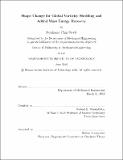| dc.description.abstract | To develop super-maneuverable underwater vehicles, one must consider how to quickly and efficiently transfer momentum between the solid body and its surrounding fluid. This thesis explores the efficient transfer of momentum to an energetic wake in the case of global vorticity shedding, as well as the recovery of momentum from the wake back to the body in the case of added mass energy recovery. Global vorticity shedding occurs when an object rapidly vanishes from the fluid. A rapid retraction is an approximation of a disappearing object, and as a result both the added mass energy as well as the entirety of the boundary layer vorticity that was originally attached to the body is deposited into the fluid. The globally shed boundary layer vorticity, under certain conditions, may evolve into lasting and coherent vortex structures that entrain the added mass energy due to the original body moving in the fluid. Such free vortices coming close to other bodies may result in large forces to effect transient motion; for example, this is how swifts can manipulate leading edge vortices generated on their wings to perform aerial acrobatics. Another example is the release of free vortices to affect bodies downstream, as in the case of fish extracting energy from an upstream wake generated either from a leading fish when within a school, or from a bluff rock as in the case of KirmAn gaiting. First we show experimentally and through simulation that the geometry of a retracting foil strongly affects the amount of deposited energy and the wake structure. A square-tipped foil, whose cross-section appears to 'vanish' in the observation plane when the foil is retracted, entrains all of the original added mass energy into its globally shed wake, but also entrains the added mass energy associated with strong ring vorticity generation at the tip, causing disruptive transient effects and incoherence in the globally shed wake. On the other hand, a streamlined-tipped foil, tapered in both the chord and thickness directions, appears to 'shrink' within the observation plane, and does not shed strong ring-like vorticity at its tip when retracted in the span-wise direction, but also sheds a much less energetic wake due to a gradually changing cross-section. Finally a hollow foil, in which the thin-walled cross-section appears to 'melt' within the observation plane, combines the best attributes of both previous geometries, avoiding the generation of strong ring vorticity at the tip, but ensuring the generation of a coherent, lasting, and fully energetic globally shed wake. Next, we demonstrate through numerical simulation and an extension of boundary vorticity flux analysis that the reduction of energy entrainment in the globally shed wake of the 'shrinking foil' is due to recovery of part of the original added mass energy by the foil through the generation of an additional pressure force. Though this recovery of energy is considered to be detrimental when the generation of strongly energetic vortical structures in the wake is desired, in other cases energy recovery is highly desirable. For example, added mass energy recovery can be used to our advantage in developing burst speed capability in flexible bodies, inspired by the impressive escape ability of octopodes enabled by their dynamic mantle shape change. For the octopus, the dynamic shape change, from an initially hyper-inflated nearly spherical shape to a streamlined ellipsoidal shape, allows for substantial added mass energy recovery from the fluid during fast jet escapes, that results in augmented thrust and much higher escape velocity than that provided by the octopus' jetting alone. While added mass energy recovery in flexible bodies is in principle possible, uncontrolled flow separation may result in substantially reduced recovery, when the energy is, instead, wasted in the formation of a large drag wake. We show through simulation and experimental validation that the amount of added mass energy recovery in a shrinking body within a viscous fluid is determined by a non-dimensional "shrinking parameter", defined as ... , where ... is the maximum shrinking speed, U is the characteristic flow velocity, and ... is the Reynolds number. We establish design criteria for shrinking bodies: Energy is recovered above a threshold value of ... 10, while operation in the range of 50 < ... < 100 results in good energy recovery, in the range of 61 - 82%. | en_US |
